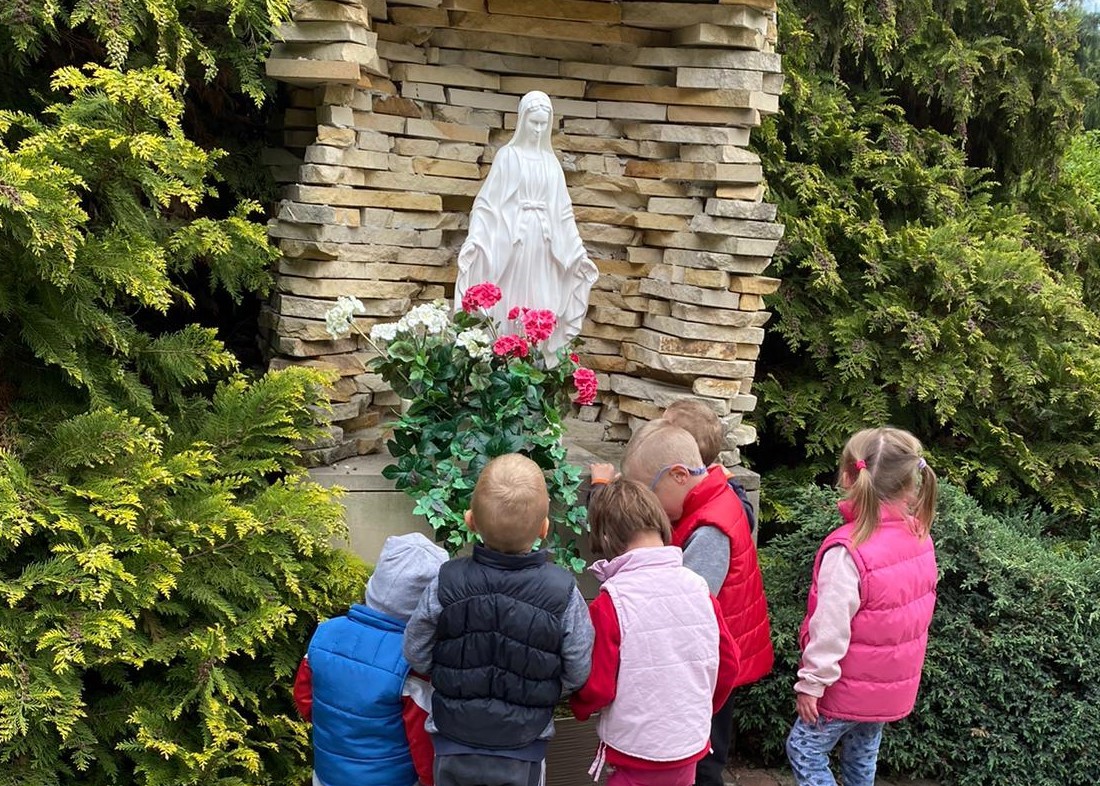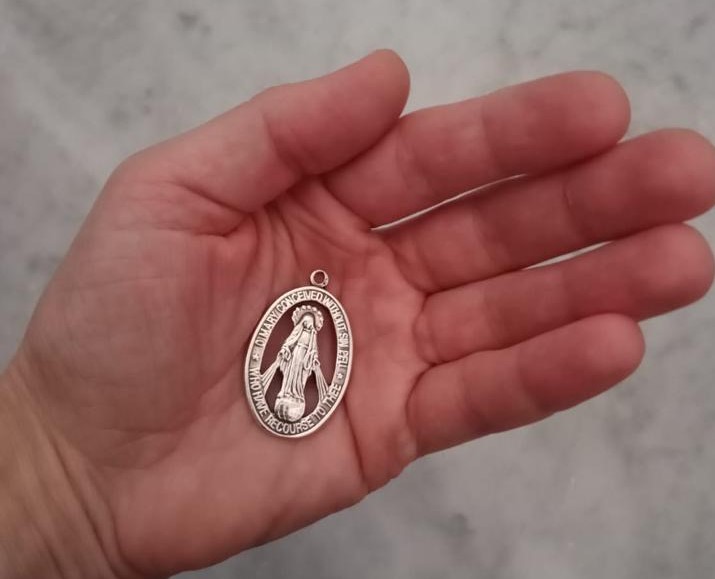
Nov 29, 2020 | SPIRITUALITY
We are sisters of Mary Immaculate and we draw our spirituality from Her.
We want to trust in God and obey Him, just as Mary
“Let it be your word for me.” (Lk 1:38)
Mary, regardless of public opinions, external circumstances or her own life situation, trusted God completely and did His will, even when she did not humanly understand where God leads her.
Sister of Mary Immaculate seeks perfect obedience to God and boundless trust in Him. She learns to seek and discern her will every day in ordinary things and in prayer.
We want to pray like Mary
“Mary kept all these things and pondered them in her heart.” (Lk 2:19)
Mary was just always with Jesus. She participated in His life and pondered and kept His words and actions in her heart.
Our prayer in the Marian spirit is a constant stand by Jesus. Not only in the chapel, but also in everyday activities. We build our bond with Him in the holy Sacraments, among other important in our spirituality is: adoration of the Blessed Sacrament, meditation and joint meditation of the Word of God and rosary prayer.
We want to look at others, their shortcomings and needs, just as Mary
And when wine ran out, Jesus’ mother said to Him, “They have no wine anymore.” (J 2,3)
Mary is close to our earthly, ordinary things. With the sensitivity of the mother, she deals with problems that seem insignificant and, as a result, cause great trouble. She reacts before we know we’re in trouble.
We learn from Mary the sensitivity to the needs of others, to notice problems that others do not pay attention to for comfort. We want to help those in need for their good and in the name of Jesus without expecting gratitude or recognition in return.
We want to continue and support the weak, the sick and the rejected, just as Mary
And next to the Cross of Jesus stood His Mother and his mother’s sister, Mary, the wife of Cleofas and Mary Magdalene. (J 19,25)
Our Lady has experienced the great, unjust suffering and painful death of Her Son. He knows what a person who is excluded by society feels rejected.
Mary teaches us attitudes towards the suffering and dying. He continues to the end and support even a quiet, compassionate presence. We try to follow her in our apostolic tasks and in our daily lives.
We want to give our lives to others every day, serving them in simple activities, just like Mary
“Behold, the handmaid of the Lord.” (Lk 1:38)
Mary, despite the fact that she did not carry out any great and spectacular works in her life, played a huge role in the Work of Salvation of Mankind. But she didn’t do it with her own efforts. Her merit was only humility and servitude, and this allowed God to act in her and to do great things through her.
In our conduct and manner of being, we cultivate humility and a well-understood ministerial attitude. Simple and joyful service characterizes our spirituality. We have given our lives to God, just like Mary, and He calls us to give it to others in His name every day.
We want to shape within us the attitude of a loving mother towards all we serve, just like Mary
So when Jesus saw the Mother and the disciple he loved next to her, he said to the Mother, “Woman, behold your son.” (J 19,26)
Mary is our Mother; she is the Mother of all people. We turn to her with confidence, and she is never indifferent to our affairs and needs.
With the personal experience of Mary’s maternal love, we also strive to shape in our way of being the mother’s attitude towards those we serve and live with. In this way, we want to realize our vocation to spiritual motherhood.
We shape our Marian spirituality by living in a religious community according to the Constitution based on the Rule of St. Augustine
“This is my mother and my brothers. For whoever does God’s will, he is my brother, sister, and mother.” (Mk 3, 34-35)
Our environment of everyday life and formation is the religious community. Here we first realize our spirituality and charism. Living in a community that operates according to strict rules is the basis of our apostolic activity.

Nov 22, 2020 | SPIRITUALITY
It happened when I was 15.
The days of my teenage life passed fast and intense, they were filled with science, with fun, meetings with peers and help at home.
Like every teenager, I also wanted to replace my wardrobe from time to time, unfortunately due to the fact that in my family we did not have much money, clothes purchases were rare and really for great events. And such a circumstance happened to me. One day I went shopping for pants. Going from shop to shop, I could find anything suitable. I knew I had to buy what would be suitable for various occasions. Weary of the long search, I decided to enter the last shop with the thought that “if I find nothing here, I will return home”.
I even liked one pair of pants, so I took them off the hanger and went to the fitting room. Unfortunately, the pants turned out to be too small. Worried that nothing I managed to find and I go home with nothing, I started getting dressed, and suddenly leaving the fitting room, I noticed that there was “something” on the ground. I bent down and I picked it up. It was a medal with the figure of Mary.
The medal was large, not as tiny as is usually worn around the neck. Surprised by what I found, I began to look around anxiously if someone might have been around has lost it. I didn’t see anybody. After a while I asked the saleswoman whether maybe she lost such a medal, but she replied “no” and since it was me who found it, it’s mine and I can take it. Returning home, I looked at it for a long time, wondering who was carrying such a big medallion? and how did he get there? ”. After returning home, I did not show anyone what I found. At that time I also thought that “no one normal wears such a big medallion around her neck, and when it is, it’s a devotee, ”which is why I didn’t want it either hanging around my neck, I just removed it away, and every now and then took it out and I watched, sometimes wondering how it happened that when I entered the fitting room I didn’t see it and what does it all mean. Over time, I forgot completely about the medal I found and the whole story.
Years passed. When I was 20, I decided to enter the Congregation and then a thought appeared “but of what?”. For this intention, I went on a walking pilgrimage to Częstochowa. There from the Vocation Center, I took several flyers, including our Congregation. In my heart I felt that it should be the so-called Marian Congregation, but also as a young girl, I paid attention to the dress of the sisters “by no chance it was not built up too much”. Looking at the flyer, it caught my attention. It said that the Sisters wear the Miraculous Medal, its photo was also posted. I made this story because it reminds me of something. After returning home, I found the “treasure” of previous years and compared with the photo I saw in the flyer were different. The one which I had, had “holes” and the one the sisters were wearing was “full”. Despite that I noticed this difference as a sign of where I should go. After joining the congregation I got to know the symbolism and meaning of this medal. I also found out to my surprise and joy that the sisters in Africa and Germany wear the same medal as I found years ago. Since then, the Miraculous Medal accompanies me every day, as does each of us.
I admit that I often forget about it, and feel guilty that I don’t wear it perhaps with the honor that is due to it, but I always make a novena before its memory, everyday I try to kiss it reverently, offering my life to Mary and looking at her, as I did when I was 15 and then not knowing that finding pants on that day wasn’t as important as finding a Wonderful mental. This medal was one of the signs that the Congregation I am in is my true place, and the once “great” medal that maybe someone “died” was supposed to wear, I wear it on my breast with pride and without fear.
Sr.M. Noemi Stanilewicz SMI

Aug 19, 2020 | SPIRITUALITY
Every year in the August 23, we celebrate the Day of Remembrance of St. Rosa of Lima, which is one of our patron saints. She is one of the saints most of whom most of us do not know much about and thus have no special relationship with her. Some of us may have wondered why our founder so revered her and gave us as our patroness.
A few years ago, this led us in the German Province to deal with it a little more intensively on one sister’s afternoon.
In conversation with the sisters, we first gathered, what we knew about her:
- She lived from the end of 1586 to 1617 and was the first Saint of South America
- She belonged to the 3rd Order of St. Dominic
- She had mystical experiences
- She tried to convert people, especially young people, to a truly Christian life.
- She cared about the poor, the sick and the marginalized
- She fasted and forned a lot.
As we continued to study her CV, we came across some notable details that made us better understand her actions.
She was a child of Spanish colonists and saw how inhuman the Spanish conquerors were with the native Indians. She suffered from this and she was looking for ways to do something about it. As a woman, she was forbidden to preach, but she tried, “with heavenly eloquent, to win over all the people with whom she dealt, that she loved the virtues, but loathed the vices.” “This quote is from St. Antonio Maria Claret, who also honored St. Rosa.
In a contribution by Dr. Markus Büning I also found the following text on these thoughts:
“Blessed Pope Innocent XI (1611-1689) said of her (St. Rosa) the following remarkable sentences: ‘There was probably no missionary in America who would have achieved more conversions with his sermons than Rosa of Lima through her prayers and penitential exercises. ‘This is perhaps the key to understanding their self-castrations. Rosa was outraged by the lives of her Spanish compatriots in the colonies. Sexual debauchery, greed for gold and money, the contempt for the native Indians and the implausible way of life of many clerics were a thorn in her side. She intuitively sensed that with such a way of life, one cannot convince an Indian of the love of the Crucified One. On the contrary, the lives of the invaders were deterred and blocked the eyes of the locals on faith in the Redeemer. She wanted to demonstrate the program of contrast with her example: in poverty and in the mystical union with the Crucified One, she wanted to show the people of Peru who this Jesus really was.”
Here we can clearly see what St. Rosa has leaved us. There is still a great deal of inhumanity and injustice in our society today. Often, we can do something about this through our actions. But often our hands are tied and we are “only” left with the prayer and witness of our lives. Above all, we are called to mission with our lives, to be salt of the earth.
Antonia Maria Claret says: “Where has our missionary spirit remained? … Rosa expresses her displeasure at not being allowed to be apostolate herself. She would like to be allowed to move from country to country and proclaim the faith to convert all unbelievers. She would prefer to walk through the streets, the cross in her hand, clothed with a belt of penance, to awaken sinners with loud shouting and to make them repent.”
St. Rosa of Lima has become the patroness of Latin America, not through great works, but through her penitentness, her intimate relationship with Christ and her self-evident devotion to the poor. For me, and I think also for a large part of the sisters who took part in these meetings in Germany, she has become a model for our spiritual life and a true patron of our Congregation. She can teach us that we can only lead people to Christ’s love and follow through our lived example and the commitment of our own lives. Each of us, where we live and work, can become apostolate of everyday life and make it fruitful through works of love.
Sr. Petra Ladig



